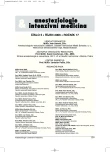Fuzzy logic in anaesthesiology as a way of thinking and a tool for practical applications
Authors:
M. Adamus 1; R. Bělohlávek 2
Authors‘ workplace:
Klinika anesteziologie a resuscitace, LF Univerzity Palackého a Fakultní nemocnice, Olomouc
1; Katedra informatiky, PřF Univerzity Palackého, Olomouc
2
Published in:
Anest. intenziv. Med., 17, 2006, č. 5, s. 246-250
Category:
Anaesthesiology - Comprehensive Report
Overview
Uncertainty and indeterminacy are typical of expert knowledge in humanities. Data processed by an expert (e. g. a medical doctor) are often imprecise, uncertain, and indeterminate. It is, however, these data according to which the expert has to make his/her decisions. Processing of indeterminate and uncertain data is the subject of fuzzy logic, which deals with fuzzy sets. In a broad variety of situations and tasks for which no precise mathematical models are available, an expert is able to formulate his/her knowledge and problem solving strategy in a natural language by means of so-called“if-then”rules. Rule-based fuzzy systems, which are based on these rules, represent a mathematical model that results directly from the expert’s experience described in a natural language. In addition to that, fuzzy systems provide us with a means of communication easily usable and thus comprehensible by a computer. Fuzzy systems can be applied to a broad spectrum of situations in medicine, such as diagnostic expert systems and feedback fuzzy control devices.
Key words:
fuzzy logic – indeterminacy – linguistic description – fuzzy control
Labels
Anaesthesiology, Resuscitation and Inten Intensive Care MedicineArticle was published in
Anaesthesiology and Intensive Care Medicine

2006 Issue 5
Most read in this issue
- Extreme hypoxic lactaemia in patients on critical care – prognosis, therapeutic options and their limitations
- Limitation of therapy in patients on ICU – a one-day national study
- Fuzzy logic in anaesthesiology as a way of thinking and a tool for practical applications
- Administration of COX-2 inhibitors modifies the course of postoperative delirium in cardiac surgery patients
